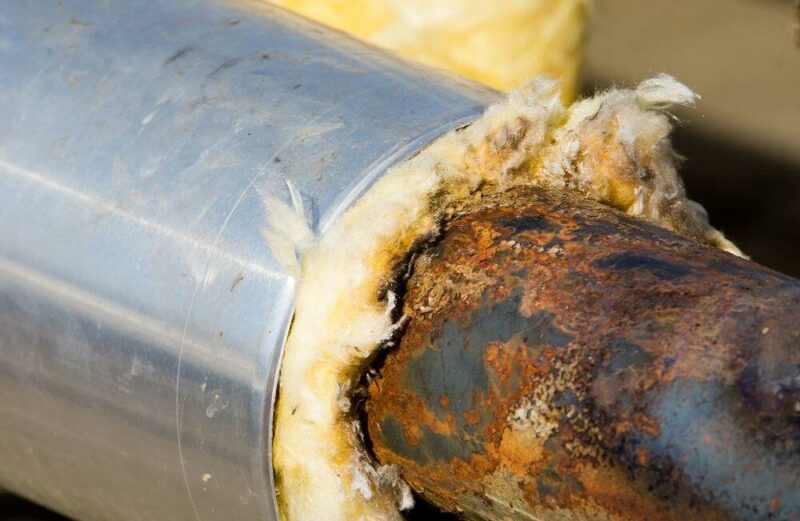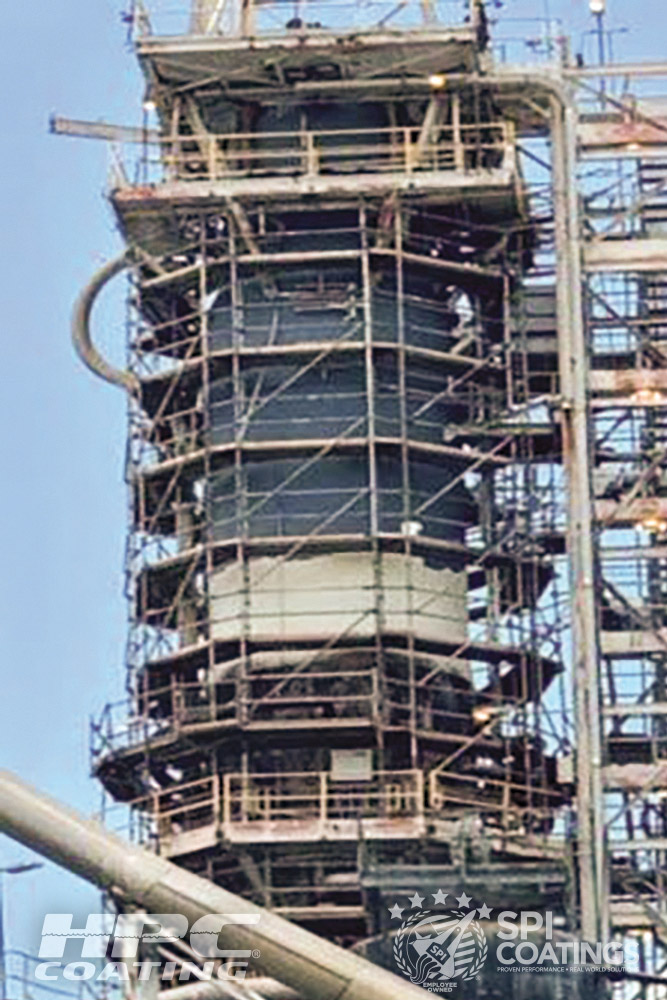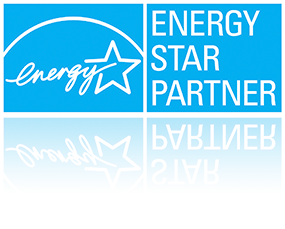Corrosion Under Insulation – CUI
While corrosion prevention may seem expensive, it is only a fraction of the indirect costs of dealing with a pipe or infrastructure failure.

According to Curtin University, corrosion under insulation (CUI) is an insidious form of corrosion caused by water entrapped within thermal insulation. In hot services, carbon steel pipes, tubes, and pressure vessels operating up to 175°C may experience CUI; while those made of austenitic and duplex stainless steels might experience CUI between 50 and 175°C. The presence of thermal insulation and jacketing slows down water evaporation and prolongs the wetting period. As a result, corrosion proceeds undetected.
The hidden nature of the CUI often makes accurate inspection and monitoring difficult. Usually, the detection of CUI can be too late; hence, resulting in disastrous outcomes such as leakages, loss of containment, and even fire and explosion. A study has shown that the petrochemical industry spends approximately 10% of the maintenance and repair budget for piping systems and pressure vessels in CUI alone.
In Europe Corrosion Under Insulation in ageing pipelines accounts for 20% of the major oil and gas incidents reported within the EU since 1984. Many assets in the North Sea are operating beyond their expected design life and 60% of pipe failures are caused by CUI. The Oil & Gas Technology Centre in the UK states the cost of CUI is rising to $5.67 trillion globally!
The Australasian Corrosion Association estimates In Australia the yearly cost of asset maintenance is estimated to be approximately $32 billion. Avoidable corrosion damage, such as CUI, accounts for $8 billion of this and continues to have a major economic impact on industry and the wider community. Corrosion under Insulation is a nagging high cost problem in the petrochemical industry. Typical mechanisms are explained and preventative measures outlined.
The new generation of ceramic designed coatings HPC, HSC, Super Therm® with Rust Grip® provide insulation without being affected by moisture and air flow. They can contain the heat at the surface level and therefore resist heat loss from the surface and holding more heat on the interior of the pipe or tank. The closed film can help prevent moisture and air to enter the coating film and therefore provide for a dramatic decrease in corrosion under insulation which is a major cause of corrosion problems in the field.
This is why the products will control “Corrosion Under Insulation” (CUI) by prohibiting the moisture load and air flows under the coatings to corrode the surfaces coated. In as much as heat ALWAYS goes to cold, the purpose of reflective insulation has been to control (slow down) the transmission of heat. Specially selected reflective ceramic compounds keeps the heat from loading onto the protected surface. If it doesn’t load, there is no need for traditional insulation. The properties of non-conductive insulation ceramics are completely different where they are required to not absorb the surface heat off of pipes or tanks and contain this heat on the surface of the pipe or tank to provide the insulation needed.
Reference
Thermal Insulation Coatings and Corrosion Controls
Author: J.E. Pritchett
Company: Superior Products International II, Inc.
Published abstract 12 Middle-East Corrosion Conference in Bahrain, February 3-6, 2008
Corrosion Under Insulation | Causes, Detection and Prevention
Author: C H O’Malley
Company: Altona Petrochemical Company
First published at the 27th ACA Corrosion Conference in 1987
Video above shows HPC® Coating being applied in 2011 at Gazprom (Russia’s largest LPG Energy supplier to Europe) and shows a 550°C hot pipe insulated down to less than 40°C in just minutes…all without a shutdown or hot permit. Manufactured by Superior Products International (SPI), Hot Pipe Coating (HPC) is available from NEOtech Coatings Australia.
The insulation underneath the jacketing plays a critical role in either promoting or inhibiting corrosion. Many facilities have found that water almost always manages to find a way into the system despite jacketing and sealants. Studies from those facilities have shown that up to 60% of insulation that has been in service for more than 10 years will contain corrosive moisture. (Learn some CUI Detection Techniques for Process Pipelines.)
Given that fact, selecting the proper insulation is important to preventing corrosion. While some suggest that using hydrophobic coatings on the pipe or a hydrophobic treatment on the insulation is the best way to prevent CUI, there is a major drawback to hydrophobic coatings. At operating temperatures above 450°F (232°C), the hydrophobic coating will gradually burn off the pipe or the insulation, leaving the system susceptible to water invasion and subsequent corrosion. Therefore we can’t rely exclusively on the jacketing system or hydrophobic coatings to prevent corrosion, we should have another plan in place for when a corrosive liquid does penetrate the system. Source
Significant corrosion with major economic and safety consequences can develop under thermal insulation, particularly when such systems function in temperatures where water is a liquid. Water may be absorbed through the insulation or reach the metal by other means. With carbon steel, acidity can accelerate the corrosion. With stainless steel chlorides can promote stress cracking.
Adding in the Indirect Costs of Corrosion
The most serious problems associated with corrosion under insulation are sudden, unanticipated failures of the process system and the high cost of replacing damaged equipment. Other common concerns include the repair costs of corroded piping and equipment, costly lost production time creates by plant shutdowns, and the potential for leaks and subsequent catastrophic failures such fire and explosion.
Note that there are indirect costs are unaccounted for in CUI. Quantifying these costs is challenging because they include the follow-on consequential expenses that result from corrosion. For example, if an underground natural gas pipeline in a neighbourhood fails due to corrosion, not only does the pipeline need to be repaired, but the homes and businesses in the neighbourhood could be without natural gas-powered utilities for several days, a gas leak could cause substantial damage if ignited (not to mention the damage to the company’s reputation) and local residents in the area could have adverse health consequences after being exposed to the natural gas. Source
While some of the cost increases are attributable to basic economic inflation, many existing structures are built from aging building materials that have outlasted their intended lifespan. These materials require additional attention (e.g., more frequent inspection and maintenance), and often must be proactively replaced to avoid creating a hazardous environment.
Real CUI incidents
An example of this was a 2008 pipe failure at a Dow Chemical plant. Although the facility had an excellent track record of inspection, maintenance and safety standards, the high-pressure pipe system was constructed from aging materials. Their inspection failed to identify corrosion on a 30-year-old pipe. When the pipe failed, it exploded with such force that it buckled in two separate places. Fortunately the buckling happened to seal the pipe, preventing further damage until the system could be shut down and averting what could have been a disastrous situation for the plant. The total loss of the plant was $18.67 million by the incident which included loss of work days of 64 days. See more >
One instance of corrosion developing into more serious problems occurred at the Alaska drill site in the mid 1980’s. A hot gas/oil pipeline that carried gas from a flow station failed because 85% of the pipe’s wall had corroded away, the result of saturated thermal insulation.
In another case, severe corrosion occurred under polyurethane (PU) insulation on a hot tank. The insulation contained halogens from the fire retardant that had been applied to it. Water had combined with the halogens to create an environment of pH 1 accelerating the corrosion process.
Georgia-Pacific – EPA ENERGY STAR Award for HPC® Coating
Outstanding NEWS: Georgia-Pacific Receives US Environmental Protection Agency (EPA) ENERGY STAR. The recognition comes for their efforts to improve energy efficiency and reduce corrosion in Koch manufacturing assets with HPC (Hot Pipe Coating).
Together with FHR, GP tested a wide range of insulation options to protect manufacturing equipment and found a solution: HPC® ceramic insulation spray. HPC reduces heat loss, prevents corrosion, and can be applied to equipment that operates at temperatures up to 1,200°F or 650°C.
The fully insulated digester reduced heat loss by 49% and saved Naheola an estimated $332,000 in energy costs annually. It also improved the quality of the cooking process by allowing the digester to better maintain its internal temperature.
Manufactured by SPI Coatings, HPC based on ceramics formulations is without doubt the leader in its field for performance, durability, energy savings and experience. Read the article >
Three primary conditions cause corrosion under insulation:
1. Moisture must be present
Otherwise corrosion cannot occur. The dissolved oxygen (DO) in water creates the potential for corrosion. As DO content increases with temperature, so does the corrosion potential. Water can be introduced from outside the insulation or from inside (condensate). Common external sources of water are atmospheric moisture condensation, water from the cleaning of equipment or deluge systems, internal leaks, rainwater, and process liquid spillage. Absorption prosperities are critical in the presence of water. Depending upon process conditions, saturated insulation may never have the opportunity to dry.
2. Carbon steel (CS) and Stainless steel (SS) issues with water chemical content
The pH level of the moisture affects CS and can cause pitting and corrosion. Acidic contamination can come from the environment or by leaching contaminants from the insulation material. In the presence of applied or residual stress and temperatures exceeding 60°C (140°F) the chloride content of water can contribute to stress corrosion cracking (SCC) austenitic SS. Chloride contamination can also come from either external sources or the insulation material itself.
3. Temperatures must be conducive to corrosion
A problem is most likely to occur between continuous operating temperatures of 0 and 100°C (32 and 212°F) because liquid moisture can exist within this range and contribute to corrosion. In cyclic temperature systems such as dual temperature process or temperature variations during shutdowns liquid moisture can exist in insulation and corrosion can occur in a relatively short period of time. Generally corrosion potential doubles for every (27 to 36°F) increase in temperature between (32 and 212°F).
In an environment where moisture, conductive pH levels, and favourable temperatures are present, the performance of a specific insulation material helps determine the likelihood of corrosion. Whether an insulation material minimises water intrusion and retention is especially critical. The most effective countermeasure against corrosive an action is to keep insulation dry. Therefore, using an insulation that minimises water intrusion and does not retain water clearly aids in the prevention of corrosion. In addition to absorbency, another factor to consider is the chemical makeup of the insulation. It should be inert, containing no chemicals that would contribute to corrosion.
Generally insulations fall into two categories: low temperature applications and high temperature applications.
Low-Temperature Insulations
Organic foam insulations such as PU, polyisocyanurate, flexible elastomerics, and phenolics are commonly used in low temperature.
In the presence of water, these insulations can contribute to corrosion problems. Like many insulation materials, they contain varying amounts of leachable chlorides, fluorides, silicate, and sodium ions as measured by ASTM C 871. Levels of leachable chlorides can range from no detectable to 200 ppm. The leachate pH can range from 1.7 to 10.0. When the leachate is found to be ≤ 6.0, special consideration should be given to protect the substrate from accelerated corrosion. Phenolics are acidic because of the acid used in their manufacture, and can develop environments to pH 1.8 in the presence of water, which can be absorbed through the insulation; this can cause extremely corrosive behaviour.
High Temperature Insulations
High temperature insulations such as calcium silicate, perlite, mineral wool, or fibrous glass are inherently porous, facilitating the entry and retention of water. At ambient temperature calcium silicate can absorb up 400% by wt when immersed in water. When wet calcium silicate is alkaline, having a pH of 9 to 10, high pH may be detrimental to coatings. Also these absorbent materials can wick moisture or flammable liquids.
Insulating Coatings
Super Therm®
Ceramic Coating Blocks 96.1% of Total Solar Heat
Super Therm® is a water-borne combination of high-performance aliphatic urethanes, elastomeric acrylics, amd resin additives which produces a tough, yet flexible coating film that’s been in operation since 1989. Designed for performance and durability, Super Therm® contains 4 unique ceramics to block up to 96.1% of Solar Radiational Heat entering a structure due to Visual Light, Ultra Violet (UV), and Infrared (IR). Super Therm® is a flexible membrane with low permeability that can greatly reduce expansion and contraction of a roof (eliminate thermal shock) and prevent corrosion and surface deterioration. > Learn More >
HPC® Coating
Get “High” Heat Insulation and Protection that Stops CUI
- HPC® Coating – Ambient up to 204°C / 400°F
- HPC®-INT – 204°C / 400°F up to 426°C / 800°
- HPC®-HT – 426°C / 800°F up to 650°C / 1200°F
HPC® Coating, HPC®-INT and HPC®-HT is a single component water-based coating designed to insulate hot pipes or surfaces that load up to 650°C. The coating is not a reflective coating but an insulation coating and works to block or hold the loading of higher heats and to resist the transfer of heat through the coating to the cooler side. Holds heat in the surface in which it covers. Once coated, the surface should be equal to the interior temperature. HPC®-HT has been successfully applied to hot pipe surfaces around 650°C. Learn More >
HSC® Coating
Get “High” Heat Protection that Surpasses Conventional Insulation
HSC® Coating is designed to control heat transfer on surface temperatures up to 350°F / 176°C. It is water-borne, and extremely lightweight and smooth in appearance. HSC® Coating uses a special acrylic resin7. blend with specific ceramic compounds added to provide a non-conductive block against heat transfer. HSC® Coating offers a “Green”, non-flammable, non-toxic formula for medium heat surface applications over standard steam pipe or oven wall construction. The coating was originally designed for hot applications where temperature exposures fall below those that would require the use of HPC® Coating. HSC® Coating is more easily applied for a smooth finish. It can be applied over metal, concrete, wood, and other substrates. Learn More
Corrosion Protection Coatings
Rust Grip®
The World’s Toughest Encapsulation Coating
Rust Grip® is a single component urethane formula applied directly to rust or blasted metal surfaces. 6780 psi surface tensile strength. Pull test results in the field and lab average 1200 psi and in the field over blasted surface at 2200 psi. Extremely tough, anchors itself inside the pores of the metal surface or surface rust to block moisture and air from developing corrosion. Simple to use and extremely effective against all corrosive environments. Applied only to completely dry surfaces. Learn More >
Moist Metal Grip
The Ideal Protection in Harsh, Wet Environments
Moist Metal Grip is a two-part epoxy coating system that has been specifically designed with specific additives to promote adhesion when used on metal. Moist Metal Grip was developed to be applied to metal surfaces that cannot be dry enough to use Rust Grip®. It can be used directly to wet or damp metal surfaces and maintain excellent adhesion to prevent further surface corrosion. It is a water repelling epoxy for use under water or in areas where constant splashing or condensation is a problem. It is resistant to chemicals and solvents, and is designed to be applied directly to concrete, masonry and wood. Learn More >


























